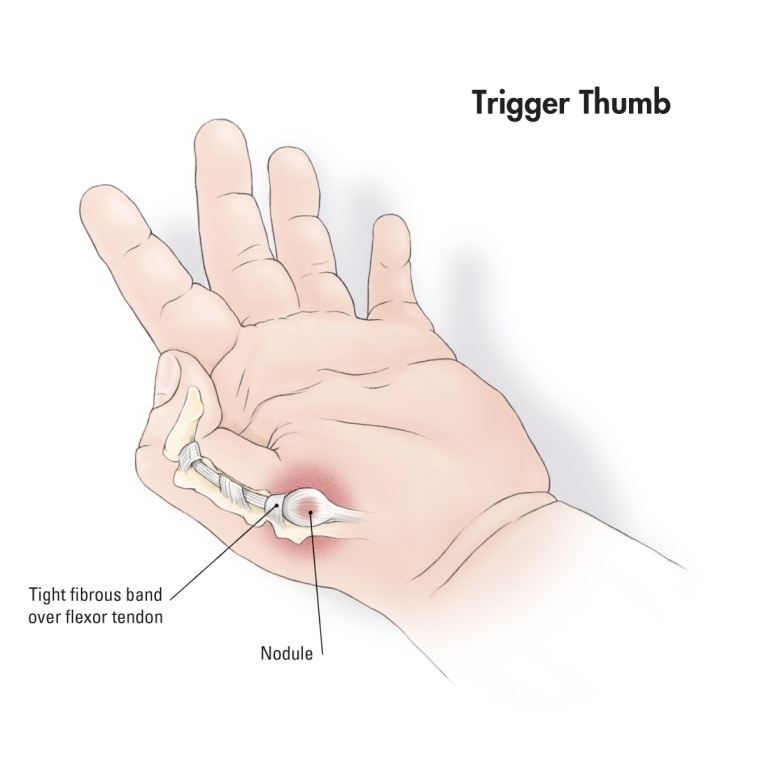
Trigger finger is a disorder in which one of your fingers gets stuck in a bent position. It may bend or straighten with a snap, like a trigger being pulled and released - hence the name 'Trigger Finger'. Some patients are known to complain about pain in the palm of the hand or the knuckles. The index finger and the thumb are generally the most vulnerable. The disorder is commonly known as ‘Historicopous’, ‘Trigger Digit’, ‘Trigger Thumb’, and ‘Stenosing Tenosynovitis’. This problem may occurs common in women to get the proper Trigger Finger physiotherapy treatment in Gurgaon contact Dr Rajesh Pal at 9811343417 and fix your appointment with top physiotherapists.
The disorder is also known as stenosing tenosynovitis. It is said to occur when the space within the sheath that surrounds the tendon in the affected finger is narrowed due to inflammation. In some severe cases of the disorder, the infected finger may even get locked in a bent position.
Although the exact cause of the disorder is ambiguous, yet several speculations indicate that it occurs when the affected finger’s tendon sheath becomes irritated and inflamed. The fibrous cords attaching muscles to bones are called tendons. These tendons are naturally surrounded by protective sheaths (one protective sheath per tendon). The inflammation of the affected finger’s tendon sheath interferes with the normal gliding motion of the tendon through the sheath and results in a bent or stuck-at-a-point finger.
Some texts refer to the disorder as ‘Stenosing Tenosynovitis’, however, this has been brushed off as a misnomer by many medical practitioners, as inflammation is not a major symptom of the disorder. Another speculation suggests the fact that repetitive forceful use of a digit leads to the subsequent narrowing of the fibrous digital sheath in which it runs. However, this is a mere speculation and does not have any significant scientific backing. The exact relationship between trigger finger and day-to-day work activities is under study and awaiting results.
Symptoms of the disorder include catching or locking of the affected finger. As the disease progresses, symptoms start getting more severe in intensity. Some patients report pain in the palm of the hand of knuckles.
Some other common symptoms of the disorder include -
Symptoms of the disorder are found to intensify gradually. They are more pronounced in the mornings or when you try to straighten or finger. Some patients also may also experience extreme symptoms while trying to grasp something.
The diagnosis of the disorder doesn't require any elaborate testing. It can be done exclusively by the medical history of the patient along with a physical examination. During the physical examination to, the medical practitioner will instruct you to open and close your hand in order to inspect areas of pain, smoothness of motion and evidence of locking. Although the disorder attacks the index finger, thumb, middle finger or ring finger most commonly, more than one finger may be affected in some rare cases. If the triggering is more severe late at night, morning, or while gripping an object firmly, inform your doctor so as to ensure the coverage of all aspects of the disease.
In some cases, the doctor may also feel your palm to check the presence of lumps, if any. If the lump is associated with trigger finger, it will show motion along with the motion of the finger. This is due to the reason that the lump is an area of swelling in part of the tendon that moves the finger.
The treatment for Trigger Finger in Gurgaon approach generally depends on how severe your symptoms are. The best way to treat the disorder is by invoking physiotherapeutic methods such as -
In a majority of the cases, heat treatment has been found to be exceptionally helpful for trigger finger. It leads to an increased flow of blood and provides extensibility to the affected tendon, thus providing relief. In case, the above methods fail to show any progress, the patient may be recommended a course of medicines or surgery.
